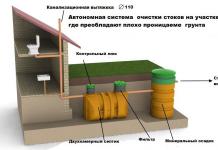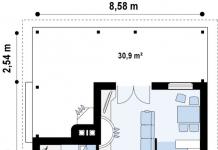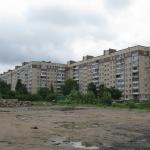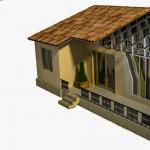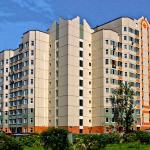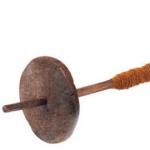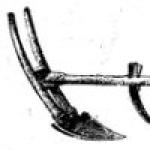Series 1LG-504D

Characteristics of the 1LG-504D series:
House type - panel
Number of storeys - 5, 9, 10, 12
Height of living quarters - 250 cm
Apartments - 1,2,3 rooms
Manufacturer - Kuznetsovsky DSK
Years of construction: 1969-2001
Cities of distribution - St. Petersburg and the region, Rybinsk, Yaroslavl region.
A note about houses 1LG-504D series in the magazine "Construction and Architecture of Leningrad 03 1978."
Modifications of this series:
- 1LG-504D, 1969-1972
“Series 1LG-504D, modification, built in 1969-1972.” It arose on the basis of the 139-apartment (with loggias) serial configuration of series 1-504, grew to 9 floors, but the panels and windows of the apartments were borrowed from there. It was built exclusively in serial configurations and mainly in the south of the city.

The first nine-story house of the 1LG-504 series - Slavy Ave. 64
 
|
| . |
Serial configurations:
o 1LG-504D-10: 9 floors, 5 front and 179 apartments with modified window frames without vents;
o: 9 floors, 7 front and 251 apartments with meridional orientation of the apartments, with a pair of loggias on the rear facade and modified window frames without vents;
- 1LG-504D, 1972-1975
“Series 1LG-504D, modification, built in 1972-1975.” Around 1972, like most other series of buildings of that period, the vents disappeared from the window frames, and the location of the air openings above the windows of the top floors also changed. They were built exclusively in serial configurations in 5-7 front houses. Most of the houses were built by 1974, but the delivery of several, mainly in the northern part of the city, was delayed for a couple of years. With rare exceptions, this modification is common in the Nevsky and Frunzensky districts.

Serial configurations:
o: 9 floors, 5 front doors and 179 apartments;
o: 9 floors, 7 front doors and 251 apartments;
o 1LG-50D-4: 9 floors, 7 front and 251 apartments with meridional orientation of apartments and a pair of loggias on the rear facade;
- 1LG-504D, 1973-1977
"Series 1LG-504D, modification, built in 1973-1977." In 1973, balconies appeared on the rear facade, one step from the end, on floors 6-9. Later, all floors except the first received balconies. During this period, houses 1LG -504D corner sections appear. Houses are built both in serial configurations and with various turns, but in a rather simple form. Several identical houses with corner sections can be considered serial configurations. With the exception of one house on Bolshevikov Avenue, all other houses are located in Vyborg and Kalininsky districts.

Serial configurations:
o: 9 floors, 10 front and 367 apartments with one corner section;
o: 9 floors, 11 front and 412 apartments with two corner sections;
o: 9 floors, 12 front and 448 apartments with two corner sections;
o Non-serial configurations;
- 1LG-504D, 1977-1980
“Series 1LG-504D, modification, built in 1977-1980.” In such houses, the air openings move back (they are placed above the windows of the apartments). But the biggest change is the change in the front windows. Instead of L-shaped, they become in one row in lower part of the panel.A modification was built at Rzhevka-Porokhov, Shuvalovo-Ozerki and Kolpino.

Serial configurations:
o: 9 floors, 2 front doors and 72 apartments;
o: 9 floors, 3 front doors and 107 apartments;
o: 9 floors, 4 front doors and 143 apartments;
o: 9 floors, 5 front doors and 179 apartments;
o Non-serial configurations;
- 1LG-504D, 1980-1982
“Series 1LG-504D, modification, built in 1980-1982.” Compared to the previous modification, the loggias on the ground floor disappeared. This modification did not take long to be built until vents appeared in the window frames of the apartments again. Found in Porokhov and on Grazhdanka .

Serial configurations:
o: 9 floors, 2 front doors and 72 apartments;
o: 9 floors, 4 front doors and 143 apartments;
o: 9 floors, 5 front doors and 179 apartments;
o: 9 floors, 5 front and 188 apartments with one corner section;
o: 9 floors, 6 front doors and 215 apartments;
o: 9 floors, 7 front and 260 apartments with one corner section;
o Non-serial configurations;
- 1LG-504D, 1982-1983
“Series 1LG-504D, modification, built in 1982-1983.” Such houses were built exclusively on Rzhevka-Porokhov (there are a couple of houses in Metallostroy) for a very short time. The only difference from the previous modification (which made it possible to distinguish such houses into a separate group) - oblong windows appeared in the window frames.

Serial configurations:
o 1LG-504D: 9 floors, 2 front doors and 72 apartments;
o: 9 floors, 3 front doors and 107 apartments;
o 1LG-504D: 9 floors, 4 front doors and 143 apartments;
o: 9 floors, 5 front doors and 179 apartments;
o 1LG-504D: 9 floors, 6 front doors and 215 apartments;
o 1LG-504D: 9 floors, 6 front and 224 apartments with one corner section;
o 1LG-504D: 9 floors, 7 front and 260 apartments with one corner section;
o Non-serial configurations;
- 1LG-504D, 1983-1989
“Series 1LG-504D, modification, built in 1983-1989.” In 1983, the window frames completely changed - they became with an expanded middle part (for three-leaf window frames), and the vents themselves became square. During the transition period, there are houses with both types of frames with windows. This modification is often found in Porokhov, in Ozerki, Komendantsky airfield and with rare inclusions in Northern Kupchino. Houses of this modification were also built with 10 floors, but in approximately 1988-89. There are also five-story modifications, mainly in the Leningrad region.Since 1987, the air openings have changed their location again - they are mainly located above the loggias. 1LG-504D2, 1989-2001
“Series 1LG-504D2, modification, built in 1989-2001.” The layout and design remained almost the same as the houses built 40 years earlier. The windows of such houses became narrower compared to previous versions. The apartments have almost The area of the kitchens has increased twice - at the expense of one of the rooms. The kitchens in all apartments have two windows and are oriented along the outer wall. This layout was called “the housewife's dream”. This modification was built mainly on Dolgoy Ozero. Sertolovo, Yanino-1 and Novy Devyatkino (it was there that the last house in the series was built - in 2001), but also as a compacting building in some areas, for example in Kupchino.The color scheme became more diverse - white, gray and purple (and sometimes green) colors were used in various combinations. This modification turned out to be the last - now the 504th series is not being built, although it went through perestroika together with some other series

Serial configurations:
o: 10 floors, 2 front doors and 79 apartments;
o: 10 floors, 3 front doors and 119 apartments;
In the seventies of the last century, panel houses of the 504 series began to be built. The reason for their appearance was that their construction was carried out faster than their analogues, and accordingly, the supply of housing increased. But the downside of such speed is the significant disadvantages of the layout - the extremely small size of the apartments and the inconvenient arrangement of the rooms. Having become the owner of an apartment in building 504, you can correct the situation with the help of redevelopment. What can be done?
The panel house 504 series has a very unique appearance and layout. The size of the apartments in it is perhaps the smallest of all the panel houses built at the end of the last century. The largest three-room apartment does not exceed 58 square meters. m., and a two-room apartment – 45 sq. m.

Another inconvenience of the layout is that the bathroom here is extremely small - even in multi-room apartments it is difficult to fit a washing machine in it. Also, the 504 series has a small kitchen - its dimensions do not exceed 6-7 square meters. m., which creates a lot of inconvenience. One-room apartments do not have any utility rooms. Two-room and three-room apartments may have a storage room, but it is extremely small. Well, the biggest inconvenience is that the layout of the apartment is extremely inconvenient for living. The rooms are most often adjacent or located inconveniently, on one side.
Important: If you need to purchase economical housing in the desired area, you should pay attention to a house of any 504 series. They are found in large numbers in any area of the city. Redevelopment will help make it comfortable for life.
Another feature of the houses is complete confusion with balconies, loggias and windows. In the first series of 504 houses, apartment windows face one side and balconies face the other. In most houses, balconies are located on one side, loggias on the other. But the windows in the 504 series are located at the correct good height and have good dimensions. And the floor in them is covered with parquet, not linoleum.
The 504d panel house series stands out, being more comfortable for living and more spacious. The kitchen in it simply pleases with its footage - 11-14 square meters. m, and in the bathroom there is a vestibule for installing a washing machine. But the improved layout of the 504d series house is much less common than the 504 house.
What can you do with the apartment?
If you have become the owner of an apartment in series 504, you should not despair. Of course, the design of the apartment will present some difficulties. But they are worth it - if you set a goal, you can create a completely comfortable option. The renovation of the apartment will involve the demolition of some walls and the merging of rooms.


There are several redevelopment options:
- combine the kitchen and one of the rooms;
- combine the kitchen and corridor;
- combine the kitchen, room and corridor into a single space.
Possible problems
Repair and redevelopment in the 504 series involve the demolition of walls. Unfortunately, in houses of this series, the interior walls are often load-bearing, unlike houses of earlier and later construction. Therefore, the future layout in the 504 series should be based on which walls are load-bearing and which are not. Based on this, the type of redevelopment is selected.
Another problem is the presence of a ceiling beam. Redevelopment of an apartment, in particular the kitchen, in houses of the 504 series involves disguising it with the help of suspended ceilings or design solutions with a multi-level ceiling and zoning. But repairs that include the installation of suspended ceilings can lead to a reduction in the ceiling height by the height of the beam. Therefore, here you need to clearly think through what will be more important - the height of the ceiling or the absence of a beam.
Features of redevelopment of a one-room apartment

In a one-room apartment of the 504 series, the size of the kitchen is depressingly small - only 6 sq.m. There is also no storage space at all. The only option for remodeling an apartment is to combine the kitchen and room into a single space.
You can choose the following options:
- demolish the wall between the room and the kitchen;
- In place of the demolished wall, place a through shelving or a bar counter with cabinets - this will to some extent replace the pantry and help solve the issue of storing things.
Important: The use of glossy stretch ceilings and furniture with glossy facades will help to visually expand the space.
Features of redevelopment of two and three-room apartments
The dimensions of an apartment of this type in the 504 series are also small. And here, too, it is worth taking the path of expanding the kitchen at the expense of other premises.
The design of the kitchen in multi-room apartments of the 504 series is changed by demolishing the wall and combining the kitchen with the living room and/or corridor. In the resulting space there is space for a dressing room. The kitchen itself for 504 series houses should be compact and linear.
It is also possible to renovate an apartment by combining the bathroom and toilet into a single bathroom. This will solve the problem of small rooms and find a place for a washing machine. The bathroom can also be expanded through the corridor.
An existing beam can be improved by making storage systems along it. The original design of the beam can make it a key accent - if you paint the beam and turn it into an art object, the apartment will take on an extraordinary look. Such repairs will not cost much, but will allow you to achieve the effect of a stylish and unique interior.
Remodeling and renovation of kitchen 504 series (video)
In this video you will see the redevelopment and renovation of not only the kitchen, but the entire apartment. In addition, you will find out the opinions and advice of the owners.
Conclusion
Of course, the layout of the 504 series is quite inconvenient. But with a little imagination, you can create a comfortable living environment in these apartments.
The kitchen of the 504 series house has a small area, but with proper use of space, you can make the interior stylish and comfortable. In the seventies of the last century, panel houses of the 504 series began to be built. The reason for their appearance was that their construction was carried out faster than their analogues, and accordingly, the supply of housing increased. But the downside of such speed is the significant disadvantages of the layout - the extremely small size of the apartments and the inconvenient arrangement of the rooms. Having become the owner of an apartment in building 504, you can correct the situation with the help of redevelopment. What can be done?
Pros and cons of the 504 series
The panel house 504 series has a very unique appearance and layout. The size of the apartments in it is perhaps the smallest of all the panel houses built at the end of the last century. The largest three-room apartment does not exceed 58 square meters. m., and a two-room apartment - 45 sq. m.
The kitchen design of the 504 series, made in a modern style, is distinguished not only by contrasting shades, but also by the functional layout of the appliances
Another inconvenience of the layout is that the bathroom here is extremely small - even in multi-room apartments it is difficult to fit a washing machine in it. Also, the 504 series has a small kitchen - its dimensions do not exceed 6-7 square meters. m., which creates a lot of inconvenience. One-room apartments do not have any utility rooms. Two-room and three-room apartments may have a storage room, but it is extremely small. Well, the biggest inconvenience is that the layout of the apartment is extremely inconvenient for living. The rooms are most often adjacent or located inconveniently, on one side.
Important: If you need to purchase economical housing in the desired area, you should pay attention to a house of any 504 series. They are found in large numbers in any area of the city. Redevelopment will help make it comfortable for life.
The 504d panel house series stands out, being more comfortable for living and more spacious. The kitchen in it simply pleases with its footage - 11-14 square meters. m, and in the bathroom there is a vestibule for installing a washing machine. But the improved layout of the 504d series house is much less common than the 504 house.
What can you do with the apartment?
 Limited space, on the one hand, makes the kitchen not very convenient, on the other hand, it allows you to cook faster, since everything is at hand
Limited space, on the one hand, makes the kitchen not very convenient, on the other hand, it allows you to cook faster, since everything is at hand
 In a small kitchen it is best to use a classic style, as well as varieties of modern ones: modern, high-tech, and so on.
In a small kitchen it is best to use a classic style, as well as varieties of modern ones: modern, high-tech, and so on.
- combine the kitchen and corridor;
Possible problems
Repair and redevelopment in the 504 series involve the demolition of walls. Unfortunately, in houses of this series, the interior walls are often load-bearing, unlike houses of earlier and later construction. Therefore, the future layout in the 504 series should be based on which walls are load-bearing and which are not. Based on this, the type of redevelopment is selected.
Another problem is the presence of a ceiling beam. Redevelopment of an apartment, in particular the kitchen, in houses of the 504 series involves disguising it with the help of suspended ceilings or design solutions with a multi-level ceiling and zoning. But repairs that include the installation of suspended ceilings can lead to a reduction in the ceiling height by the height of the beam. Therefore, here you need to clearly think through what will be more important - the height of the ceiling or the absence of a beam.
 Pay special attention to lighting - its lack will reduce the space. In a one-room apartment of the 504 series, the size of the kitchen is depressingly small - only 6 sq.m. There is also no storage space at all. The only option for remodeling an apartment is to combine the kitchen and room into a single space.
Pay special attention to lighting - its lack will reduce the space. In a one-room apartment of the 504 series, the size of the kitchen is depressingly small - only 6 sq.m. There is also no storage space at all. The only option for remodeling an apartment is to combine the kitchen and room into a single space.
Important: The use of glossy stretch ceilings and furniture with glossy facades will help to visually expand the space.
An existing beam can be improved by making storage systems along it. The original design of the beam can make it a key accent - if you paint the beam and turn it into an art object, the apartment will take on an extraordinary look. Such repairs will not cost much, but will allow you to achieve the effect of a stylish and unique interior.
Remodeling and renovation of kitchen 504 series (video)
In this video you will see the redevelopment and renovation of not only the kitchen, but the entire apartment. In addition, you will find out the opinions and advice of the owners.
Conclusion
Of course, the layout of the 504 series is quite inconvenient. But with a little imagination, you can create a comfortable living environment in these apartments.
Series 1LG-504D

Characteristics of the 1LG-504D series:
House type - panel
Number of storeys - 5, 9, 10, 12
Height of living quarters - 250-270 cm
Apartments - 1,2,3 rooms
Manufacturer - Kuznetsovsky DSK
Years of construction: 1969-1993
Cities of distribution - St. Petersburg and the region, Rybinsk, Yaroslavl region.
Modifications of this series:
- 1LG-504D, 1969-72
"Series 1LG-504D, modification, built in 1969-1972." It arose on the basis of the 139-apartment (with loggias) serial configuration of series 1-504, grew to 9 floors, but the panels and windows of the apartments were borrowed from there. It was built exclusively in serial configurations and mainly in the south of the city.

The first house of the 1LG-504 series - Slavy Ave. 64 .
Serial configurations:
o: 9 floors, 5 front doors and 179 apartments;
o 1LG-504D-10: 9 floors, 5 front and 179 apartments with modified window frames without vents;
o: 9 floors, 7 front doors and 251 apartments;
- 1LG-504D, 1977-80
“Series 1LG-504D, modification, built in 1977-1980.” In such houses, the air openings move back (they are placed above the windows of the apartments). But the biggest change is the change in the front windows. Instead of L-shaped, they become in one row at the bottom of the panel. A modification was built at Rzhevka-Porokhov and Shuvalovo-Ozerki.

Serial configurations:
o: 9 floors, 2 front doors and 72 apartments;
o 1LG-504D: 9 floors, 3 front doors and 107 apartments;
o 1LG-504D: 9 floors, 4 front doors and 143 apartments;
o 1LG-504D: 9 floors, 5 front and 179 apartments;
o Non-serial configurations;
- 1LG-504D, 1980-82
“Series 1LG-504D, modification, built in 1980-1982.” Compared to the previous modification, the loggias on the ground floor have disappeared. This modification did not take long to build until vents appeared in the window frames of the apartments again. Found in Porokhov and Grazhdanka.

Serial configurations:
o 1LG-504D: 9 floors, 2 front doors and 72 apartments;
o 1LG-504D: 9 floors, 6 front doors and 215 apartments;
o 1LG-504D: 9 floors, 6 front and 224 apartments with one corner section;
o 1LG-504D: 9 floors, 7 front and 260 apartments with one corner section;
o Non-serial configurations;
- 1LG-504D, 1983-89
"Series 1LG-504D, modification, built in 1983-1989." In 1983 The window frames have completely changed - they have an expanded middle part (for three-leaf window frames), and the windows themselves have become square. During the transition period, there are houses with both types of frames with vents. This modification is often found in Porokhov, in Ozerki, Komendantsky airfield and with rare inclusions in Northern Kupchino. Houses of this modification were also built with 10 floors, but in 1988-89. approximately. There are also five-story modifications, mainly in the Leningrad region. Since 1987 the air openings have changed their location again - they are mainly located above the loggias.

Serial configurations:
o: 5 floors, 3-5 front;
o 1LG-504D: 9 floors, 3 front doors and 107 apartments;
o 1LG-504D: 9 floors, 4 front doors and 143 apartments;
o 1LG-504D: 9 floors, 5 front doors and 179 apartments;
- 1LG-504D2, 1989-93
“Series 1LG-504D2, modification, built in 1989-1993.” The layout and design remained almost the same as the houses built 40 years earlier. The windows of such houses have become narrower compared to previous versions. The kitchen area in the apartments has almost doubled - at the expense of one of the rooms. This modification was built mainly on Dolgoye Ozero, but also as a compaction building in some areas, for example in Kupchino. The color scheme became more varied - white, gray and purple (and sometimes green) colors were used in various combinations. This modification turned out to be the last - now the 504th series is not being built, although it went through perestroika together with some other series.

Serial configurations:
o: 10 floors, 2 front doors and 79 apartments;
o: 10 floors, 3 front doors and 119 apartments;
o Non-serial configurations;
Section: Types and classes of houses
The 504 series is not much different from the “ship”, but its main difference is the location of the windows not under the ceiling, but at a normal level, and parquet floors instead of linoleum. The layout of the 504 series is not very good - there are two options: adjacent rooms and a one-sided apartment. The area of the apartment is small (“three rubles” - 58 sq.m., double-sided with two loggias). The one-room apartment does not have storage rooms or built-in wardrobes.
The total area of the apartments is 44-45 sq. m. m. two-room and 54-58 sq.m. - three-room apartment.
Episode 504 valued more than “Khrushchev” buildings (due to the presence of an elevator and large footage), but less than other panel houses. The advantage of this series is that the houses were built in almost all areas, which makes it possible to find inexpensive housing where it is needed.
In terms of cost, apartments of the 504 series are slightly more expensive than “ships”.
504D series - 1LG504D2 - an improved series 1LG504, which looks much more attractive than the previous one. The one-room apartments of the 504D series are large in area and have a rather large kitchen - 13.5 sq. m. m. and loggia. The bathtub has a vestibule for installing a washing machine, which was not possible in the 504 series. In two-room apartments, the kitchen is 11.8 sq.m., and there are two loggias. 3- and 4-room apartments are in short supply here. Houses of the 504D series were built mainly at the Commandant airfield and in Kamenka.
In the seventies of the last century, panel houses of the 504 series began to be built. The reason for their appearance was that their construction was carried out faster than their analogues, and accordingly, the supply of housing increased. But the downside of such speed is the significant disadvantages of the layout - the extremely small size of the apartments and the inconvenient arrangement of the rooms. Having become the owner of an apartment in building 504, you can correct the situation with the help of redevelopment. What can be done?
Pros and cons of the 504 series
The panel house 504 series has a very unique appearance and layout. The size of the apartments in it is perhaps the smallest of all the panel houses built at the end of the last century. The largest three-room apartment does not exceed 58 square meters. m., and a two-room apartment - 45 sq. m.

Another inconvenience of the layout is that the bathroom here is extremely small - even in multi-room apartments it is difficult to fit a washing machine in it. Also, the 504 series has a small kitchen - its dimensions do not exceed 6-7 square meters. m., which creates a lot of inconvenience. One-room apartments do not have any utility rooms. Two-room and three-room apartments may have a storage room, but it is extremely small. Well, the biggest inconvenience is that the layout of the apartment is extremely inconvenient for living. The rooms are most often adjacent or located inconveniently, on one side.
Important: If you need to purchase economical housing in the desired area, you should pay attention to a house of any 504 series. They are found in large numbers in any area of the city. Redevelopment will help make it comfortable for life.
Another feature of the houses is complete confusion with balconies, loggias and windows. In the first series of 504 houses, apartment windows face one side and balconies face the other. In most houses, balconies are located on one side, loggias on the other. But the windows in the 504 series are located at the correct good height and have good dimensions. And the floor in them is covered with parquet, not linoleum.
The 504d panel house series stands out, being more comfortable for living and more spacious. The kitchen in it simply pleases with its footage - 11-14 square meters. m, and in the bathroom there is a vestibule for installing a washing machine. But the improved layout of the 504d series house is much less common than the 504 house.
What can you do with the apartment?
If you have become the owner of an apartment in series 504, you should not despair. Of course, the design of the apartment will present some difficulties. But they are worth it - if you set a goal, you can create a completely comfortable option. The renovation of the apartment will involve the demolition of some walls and the merging of rooms.


There are several redevelopment options:
- combine the kitchen and one of the rooms;
- combine the kitchen and corridor;
- combine the kitchen, room and corridor into a single space.
Possible problems
Repair and redevelopment in the 504 series involve the demolition of walls. Unfortunately, in houses of this series, the interior walls are often load-bearing, unlike houses of earlier and later construction. Therefore, the future layout in the 504 series should be based on which walls are load-bearing and which are not. Based on this, the type of redevelopment is selected.
Another problem is the presence of a ceiling beam. Redevelopment of an apartment, in particular the kitchen, in houses of the 504 series involves disguising it with the help of suspended ceilings or design solutions with a multi-level ceiling and zoning. But repairs that include the installation of suspended ceilings can lead to a reduction in the ceiling height by the height of the beam. Therefore, here you need to clearly think through what will be more important - the height of the ceiling or the absence of a beam.
Features of redevelopment of a one-room apartment
 In a one-room apartment of the 504 series, the size of the kitchen is depressingly small - only 6 sq.m. There is also no storage space at all. The only option for remodeling an apartment is to combine the kitchen and room into a single space.
In a one-room apartment of the 504 series, the size of the kitchen is depressingly small - only 6 sq.m. There is also no storage space at all. The only option for remodeling an apartment is to combine the kitchen and room into a single space.
You can choose the following options:
- demolish the wall between the room and the kitchen;
- In place of the demolished wall, place a through shelving or a bar counter with cabinets - this will to some extent replace the pantry and help solve the issue of storing things.
Important: The use of glossy stretch ceilings and furniture with glossy facades will help to visually expand the space.
Features of redevelopment of two and three-room apartments
The dimensions of an apartment of this type in the 504 series are also small. And here, too, it is worth taking the path of expanding the kitchen at the expense of other premises.
The design of the kitchen in multi-room apartments of the 504 series is changed by demolishing the wall and combining the kitchen with the living room and/or corridor. In the resulting space there is space for a dressing room. The kitchen itself for 504 series houses should be compact and linear.
It is also possible to renovate an apartment by combining the bathroom and toilet into a single bathroom. This will solve the problem of small rooms and find a place for a washing machine. The bathroom can also be expanded through the corridor.
An existing beam can be improved by making storage systems along it. The original design of the beam can make it a key accent - if you paint the beam and turn it into an art object, the apartment will take on an extraordinary look. Such repairs will not cost much, but will allow you to achieve the effect of a stylish and unique interior.
Attention, TODAY only!






Series 1LG-504 is a long-lived project. The first versions of the buildings, in most respects, belong to the “Khrushchev” buildings; they were developed to replace the 1LG-507 series at LenNIIproekt in 1962-62. The project was approved, and construction was entrusted to DSK-4 (Kuznetsovsky). The basic series (1LG-504-3) received its first new residents in 1964. These were five-story buildings, which were not much different from the predecessor series. In 1968, according to the design of architect D. S. Goldgor, the series was modified - 1LG-504D - it grew to nine floors, acquired an elevator, a garbage chute, a lobby and a stroller room. The first buildings of the improved DSK-4 series began to be commissioned in 1969. Later, under the leadership of architect I.I. Kuskov, the team of workshop No. 16 of LenNIIproekt increased the number of storeys in the series to 12 (1975) and even to 16 (1980), nevertheless, DSK for the most part continued to build nine-story buildings. In 1991, another modification of the project took place - 1LG-504D2. These are 10- and 16-story buildings. Construction of the standard project of the series was discontinued in 1996.
The layout of apartments 1LG-507, with rooms close to square proportions and relatively spacious kitchens (8-11 sq. m.), was considered successful and remained almost unchanged until production was discontinued. The disadvantages of the series are considered to be small hallways, which were even sometimes attached to a room or kitchen.
Section 1LG-507, four apartments per landing. The most common configurations are 2-2-3-3 and 1-3-3-4 for row sections and 2-3-3-4 and 1-2-3-4 for end sections. The ground floors are often equipped with shops and consumer services, which occupy an eighth of the total area of the project's buildings.
Double-leaf and three-leaf windows of the 1LG-504 series with disproportionate sashes. This allows you to organize winter ventilation systems and save on installing climate control supply valves in the frames. However, high altitudes, which means significant wind loads, require the installation of reliable window fittings (hinges, fixation and locking systems). In addition, a significant part of the buildings of the 1LG-504 series were erected along busy highways. This involves choosing more noise-insulating double-glazed windows (triple, asymmetrical or argon-filled) for windows.
The definitions of “panel”, “brick” or “monolith” upon closer examination do not bring clarity: brick is different from brick, and one can only guess about the layout of the apartments in the house. The series number of the house’s construction tells you how many loggias and storage rooms there are in the apartment, and what the height of the ceilings is, but very few people can “decipher” it.
Monument houses
The oldest houses in St. Petersburg are called “old foundation”. Most of them are pre-revolutionary buildings, including rebuilt barracks and warehouses. There are several thousand such buildings in the city center. The layout of such houses can be different: from the “corridor system”, when one toilet was intended for almost 40 small rooms, to multi-storey apartments with an area of several hundred square meters.
The old stock is divided into two categories: houses with and without major repairs. The latter are very old houses with wooden floors or metal beams. Such ceilings began to be made in the 70s of the 19th century.
In Soviet times, major renovations were carried out in old buildings several times. It was made as part of the reconstruction of the late 60s - early 70s and reconstruction of the late 70s - early 80s. And if in the 60s major renovations took place sporadically and without redevelopment, then in the 70s and 80s only the outer walls remained of the buildings, but everything changed inside. Massive stucco on the ceilings and walls, columns, fireplaces, paneled doors - everything was swept away in the name of practicality and convenience of the Soviet citizen. If the customers for the renovation were enterprises and organizations, the apartments turned out to be similar to those that we now call “good Stalinist ones.” During the mass reconstruction of the housing stock, apartments in such houses turned out to be more similar to the current "brezhnevka".
Reconstruction of old houses was also carried out in the 90s of the twentieth century, but it is difficult to describe such work: in some cases they were carried out according to high European standards, in others quick selective repairs were carried out with partial resettlement. Today, these houses are often classified as elite.
The crown of constructivism
The undoubted masterpieces of twentieth-century architecture are Stalinist buildings. You can talk for a long time about their appearance, aesthetics and harmony, but these houses will last for many more decades. There are especially many such houses in the Moskovsky and Kirovsky districts, and if we talk about entire ensembles, then these are Moskovsky Avenue and Stachek Avenue. It is easy to distinguish them: it is almost always a monumental building made of brick or durable ceramic panels, with a high mezzanine, lined with granite tiles or chips.
Stalin's houses were built both for ordinary workers and for the nomenklatura. The houses for the elite included offices and children's rooms, libraries and servants' rooms, not to mention the things familiar to us today - elevators and garbage chutes. The ceiling height was from 3 meters, the area of the rooms was from 15 to 25 sq.m., and in some places even up to 30 sq.m., several utility rooms.
In the post-war period, until 1956, Stalinist houses were built more standardized, without decorations, complex facade decorations and stucco. But even such Stalinist buildings are superior in all respects to what was built later.
“There is a general pattern: the price of construction and the durability of the building are related,” says Vladimir Sparak, Deputy General Director of ARIN. “The construction of a Stalin building cost more than the construction of a Khrushchev building with all the ensuing consequences regarding the strength of the structure.”
Architectural thaw
Khrushchev buildings, the design of which had been carried out since the late 1940s, went into production after the historical decree of 1955 “On the elimination of excesses in design and construction”: “The externally ostentatious side of architecture, replete with large excesses,” characteristic of the Stalin era, now “does not correspond lines of the Party and the Government in architectural and construction matters. Soviet architecture should be characterized by simplicity, rigor of forms and economical solutions.”
Communal apartments were declared an economically disadvantageous type of housing, a social problem that was proposed to be solved through mass construction. The party demanded that projects be developed by the autumn of 1956 to dramatically reduce the cost of housing construction and make it affordable for workers. This is how the famous “Khrushchev buildings” appeared. According to the plan, in 1980 every Soviet family was supposed to "meet communism" in a separate apartment. Initially, by the way, it was assumed that by this historical moment, the five-story buildings of the first generation would be demolished: they were given a 25-year service life.
There is no localization of Khrushchev houses in St. Petersburg, they are scattered throughout the city, usually located not far from the metro. According to the project, almost all the buildings are five-story buildings without an attic, garbage chute, or elevator, but each apartment has a storage room, a bedroom (6 sq.m. for one person, 8 sq.m. for two) and a common room (at least 14 sq.m. m.). The area of a one-room apartment is 30-43 sq.m., a 2-room apartment is 41-46 sq.m., a 3-room apartment is 54-62 sq.m., a 4-room apartment is 62-72 sq.m.. Poor heat - and sound insulation, low ceilings (2.5 sq.m.), combined bathrooms, you often see rooms measuring 3-4 sq.m.
Series 1-507, whose houses are numerous in the Moskovsky district, are the highest quality panel Khrushchev buildings. They have a “large” kitchen compared to ordinary Khrushchev apartments - about 7 sq.m., interfloor ceilings with hollow-core flooring, and separate bathrooms. Three-room apartments must have adjacent rooms.
Five-story buildings series 1-335 They are distinguished by insulated external walls with a layer of mineral wool. The apartment layouts are similar to series 1-507, but the bathrooms are often adjacent, the interior partitions are very thin, and the sound insulation is low.
GI series appeared in the early 1960s, and I must admit, this is far from the most successful series of houses. Despite the number of rooms (from three), their sizes left much to be desired: bedrooms from 6 to 9 sq.m., living room 15 sq.m., combined bathroom - 2.2 sq.m., cramped hallway and kitchen 5.5 sq.m. The ceilings in the bathrooms were only 2.3 m. The walls of such houses have very high thermal conductivity, which is why the houses are too cold in winter and very hot in summer. In addition, according to modern standards, the building materials of houses in this series contain an increased content of asbestos, which is harmful to health.
At home OD series- the coldest of all Khrushchev buildings. And given the thickness of the partitions at 4 cm, it creates the impression of a kind of “house of cards”.
Brick buildings episodes 1-528 And 1-527 are considered high quality by definition: they are made of brick. Such houses were rented out with expensive window frames, good parquet and paneled doors. Despite the obvious advantage in the form of high ceilings (2.8 m), the area of apartments in such houses is the most Khrushchev-like. However, if series 1-527 almost repeats series 1-507, only in brick, then series 1-528 is found mostly in the prestigious "Stalinist" quarters of the Moscow region and the Petrograd side, as well as in the nearest suburbs.
“Most of the Khrushchevs have already expired, or are close to it,” explains Nikolai Lavrov, deputy director of the Bekar Academy of Sciences. – Half a century is the “ceiling” for Khrushchev buildings, after which they can begin to collapse. Even now, these houses do not meet the standards for thermal conductivity, for the safety of pipes. The panels deteriorate, the seams open over time, cold air begins to pass through them. The roofs are already worn out and starting to leak. Such houses require resuscitation, not treatment, and endless resuscitation.”
"Unmodern" panel
“Brezhnevka” buildings include houses built from the late 60s to 1990. In 1970, the Unified catalog of building details was adopted, on the basis of which standard projects were subsequently developed.
Panel Brezhnevkas are improved Khrushchevkas. In such houses the area of the rooms is larger, and kitchens can be up to 7 sq.m. The ceiling height increased to 2.7 m, elevators and garbage chutes appeared in the entrances.
Apartments in houses series 504 have the smallest area of all panel series of Brezhnevkas. In one-room apartments there are no closets and built-in wardrobes, and sometimes balconies with loggias. There are practically no three- and four-room apartments in the houses. However, these houses differ from the famous "ships" in the location of windows at the usual level, and not under the ceiling, and parquet, not linoleum floors.
In those days, houses of the 504 series were built according to the principle “the faster, the better,” says Nikolai Lavrov, deputy director of the Bekar real estate agency. –The builders didn’t pay much attention to quality. Therefore, their service life is not long - they still have 20 years left.”
Series 1LG504D2– improved series 504. One-room apartments have a spacious kitchen of 13.5 sq.m. and a large total area, and in the bathroom there is a small vestibule for installing a washing machine. In two-room apartments, the kitchen is slightly smaller, but there are two loggias. Such houses were built only in the Primorsky district.
At home series 1-Lg-602 were built from the mid-60s. They differed from Khrushchev apartments in the presence of elevators and garbage chutes; otherwise, these were not the most comfortable apartments: the one-room apartments had no storage rooms, and the kitchens were “sandwiched” between the outer wall and the monolithic plumbing cabin, which made redevelopment almost impossible. On the staircase landings, the windows are elongated in a horizontal plane; there are four apartments on each landing.
Most houses series 1-Lg-606– housing construction cooperatives. Of all the panel Brezhnevka houses, these are the warmest and most comfortable houses with good sound insulation, thick external walls and large windows with wide window sills. They are valued higher than other panel Brezhnevkas. Neither the elevator shaft nor the garbage chute border the apartments, and the latter can be easily redeveloped. There are 6-7 apartments on the landing, all the walls between them are load-bearing.
Series 1-Lg-600– famous St. Petersburg “house-ships”. These are 9 - 12 - 15-storey buildings with different numbers of entrances, designed according to a new principle - block-sectional. There are many such houses in the Krasnoselsky and Kirovsky districts. There are practically no one-room apartments in them, but there are five-room apartments, with a walk-through room of 18 sq.m., from which you can exit into three tiny bedrooms from 6 to 8 sq.m. The kitchen is the same size. In addition to the fact that the windows are located right at the ceiling, in some rooms of the “ships” they are very narrow, without window sills. Almost all the walls in the apartments are permanent, and redevelopment is impossible.
According to experts, of all the Brezhnevkas, the “ships” have the least time left: “Ships are the next series in terms of strength after the Khrushchevkas,” says Nikolai Lavrov. “They are in slightly better condition than Khrushchev, and their shelf life is a little longer.”
Series 1-528KP-41- These are Brezhnev brick 9-story buildings with rooms from 10 to 21 sq.m. and a small kitchen from 6 to 8 sq.m. Small but separate bathrooms, equally small, L-shaped hallways and long, narrow rooms in two- and three-room apartments. Corridor-type staircase. Sound insulation is an order of magnitude higher than in panel Brezhnevkas.
Series 1-528KP-80- These are single-entrance dotted houses of 14 floors. A distinctive feature of such houses is large loggias with two windows in all apartments. The area of the kitchens is about 8 sq.m. The entrances are most often spacious, with intercoms, concierges and video surveillance systems, with two elevators and a back staircase with a separate entrance.
Panel episode 121 stands out a bit from the “Brezhnevka” series: it was produced both before 1990 and after. The later houses of this series belong to the category of “modern panel”. The apartments of the houses in this series have spacious kitchens starting from 9 sq.m. In later versions, the apartment area is larger than in the earlier Brezhnev versions. Initially, the houses in this series were 5-story, without elevators. They were built mainly in regional centers and villages. When such houses began to be built in St. Petersburg, they became 9-10 storeys, with elevators and garbage chutes. The first houses were faced with contrasting beige-brown tiles; later the colors of the tiles became more varied.
Old methods in a new way
Both panel and brick housing construction still exists today. However, despite previous definitions, construction technologies are completely different.
Already familiar to us episode 121 grew to 16 floors. Such houses have three-layer panels of external walls and triple glazing. Interpanel joints are sealed with silicone sealants. The houses are delivered with full high quality finishing. There is no need to complain about the area: kitchens from 12 sq.m., three-room apartments - from 80 to 92 sq.m.
Series 137 perhaps the most popular of all modern panels. The classics of this series are houses similar to houses series 606. At the end of the 80s, the most prestigious houses of this series, 137.11, were built. These are houses with two elevators separated from the main area by a staircase, kitchens from 10 sq.m., hallways from 5 sq.m., in three-room apartments - up to 13 sq.m. True, when choosing an apartment in such a house, you need to take into account the floor: balconies and loggias begin only from the third floor, and in earlier modifications of this series - from the sixth floor.
But there are other options for the 137 series. For example, a monolithic-panel version with a monolithic frame and external wall panels. The main disadvantage of such houses is poor sealing of joints. Near the metro station "Rybatskoye" you can see a lot of monolith-brick houses of series 137. The material used for the external walls was sand-lime brick with a layer of expanded polystyrene.
At home series 600.11 have aerated concrete walls, apartments with loggias and square kitchens up to 11 sq.m., with L-shaped windows.
In the mid-90s, it appeared on the market series 1.090.1, similar to series 121. But in such houses the ceilings are higher than three meters, the facade is made of granite chips, and the roof is made of colored metal tiles. The three-room apartments have two bathrooms, and on the top floors it is possible to install fireplaces.
Among other panel houses, the common features of which are high number of storeys, external walls made of three-layer panels, variations of apartments from one to five rooms and the presence of two elevators, some series with unique features can be distinguished. For example, in houses of the series P-46, P-46M,P-3M, P-44,P-44T And P-44M quite low ceilings - only 2.6 m. In the houses of the series P-111M underground garages are usually available. And in the houses series PD-4 The first floor is non-residential, but the ceilings in the apartments are 2.75 m.
“Modern brick” includes 16-story buildings series 1-528KP-82. These are aerodynamically shaped dotted houses with non-standard spacious loggias and kitchens from 7 to 8.5 sq.m. and small rooms from 11 to 19 sq.m. But in multi-room apartments you can see two large balconies, and spacious hallways are a feature of all apartments in the houses of this series, as well as large closets and closets. Comfortable bathrooms with transverse bathtubs.
Modern series of panel houses are designed for a service life of 50 years. However, experts advise when choosing a house built in the last 20 years, look not only at the series, but also directly at the year of construction:
“During a crisis, problems often arise in the quality of projects,” explains Vladimir Sparak, Deputy General Director of ARIN. “Therefore, those houses that were commissioned in 1992 differ significantly in the quality of the structure from the houses that were commissioned before and after this period.”
